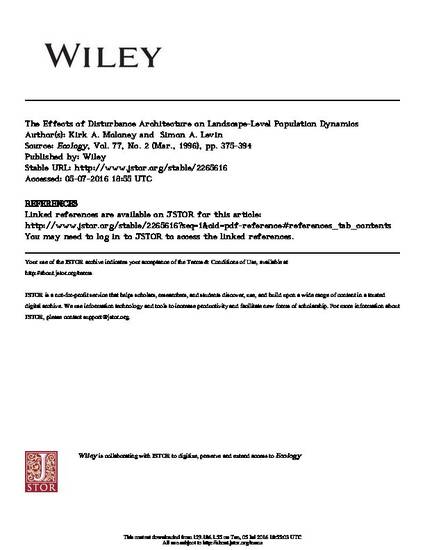
Article
The Effects of Disturbance Architecture on Landscape-Level Population Dynamics
Ecology
Document Type
Article
Disciplines
Publication Version
Published Version
Publication Date
3-1-1996
DOI
10.2307/2265616
Abstract
Phenomena such as disturbance play a major role in structuring ecological systems by producing a spatiotemporal mosaic of patches at different successional states. The distribution of species within the resulting mosaic depends upon an interaction between species' life history traits and the spatial and temporal structure of the ecological processes controlling species' distributions. We have used a spatially explicit simulation model (Jasper) of a serpentine grassland to examine the importance of some of these relationships, focusing primarily on the role of disturbance. The model Jasper is hierarchical in design and was developed to simulate the population dynamics of three interacting plant species: Bromus mollis, Calycadenia multiglandulosa, and Plantago erecta. Population dynamics were modeled as occurring within local sites, which were then arranged in a square array to form a landscape. Connections among sites within a landscape were made primarily through seed dispersal. Several components of disturbance architecture were varied systematically among model runs to determine their impact on population dynamics at the scale of the landscape. We considered three levels of organization in modeling disturbance: (1) overall rate of disturbance, (2) size of individual disturbances, and (3) temporal and spatial autocorrelation among individual disturbances. The results demonstrate that the impact of disturbance depends upon a complex interaction between the life history characteristics of the species making up the community and the spatial and temporal structure of the disturbance regime. For example, we found that the biggest impact on species abundance occurred in response to a shift in the temporal autocorrelation structure of the disturbance regime. Also, species diversity was found to increase at intermediate levels of disturbance (as has been shown in several other studies). However, what can be considered an intermediate level of disturbance depends as much upon the temporal autocorrelation structure of the disturbance regime as it does upon the absolute rate of disturbance. These results suggest that predicting the impact of disturbance on ecological communities will require an explicit understanding of at least some aspects of the spatial and temporal architecture of the disturbance regime.
Rights
Copyright by the Ecological Society of America
Copyright Owner
Ecological Society of America
Copyright Date
1996
Language
en
File Format
application/pdf
Citation Information
Kirk A. Moloney and Simon A. Levin. "The Effects of Disturbance Architecture on Landscape-Level Population Dynamics" Ecology Vol. 77 Iss. 2 (1996) p. 375 - 394 Available at: http://works.bepress.com/kirk-moloney/10/

This article is from Ecology 77 (1996): 375, doi: 10.2307/2265616. Posted with permission.